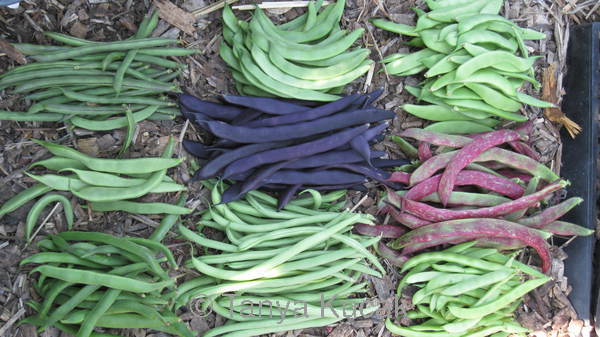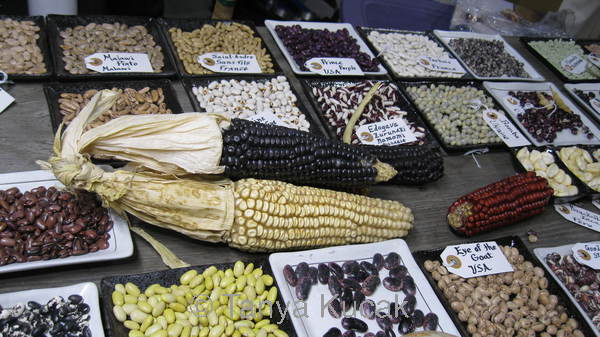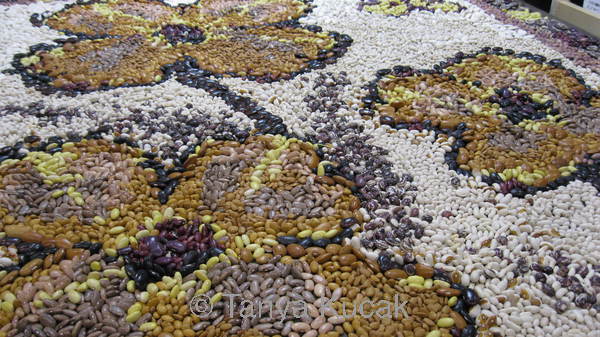
I started saving seed in earnest some years ago when I got a few seeds of a flavorful Swiss bean and discovered, after I fell in love with it, that it's not available in the U.S. So each year I let a few pods go to seed, and I still grow it. I've grown at least 30 other varieties of uncommon pole beans, and dozens more are available commercially. The diversity of colors, shapes, and sizes of the beans themselves and the pods are interesting, and it's fun to discover new flavors.
The tables loaded with dozens of varieties of beans, many not yet available commercially, were a highlight of this year's San Francisco Flower and Garden Show. The beans at the Baker Creek Heirloom Seed Co. display were collected by Joseph Simcox, a botanical explorer who travels the world to find edible species and is working with Baker Creek to get more diversity into the seed catalog. Heirloom seed is defined as open-pollinated seed that has been grown for at least 50 years.
Simcox showed slides of unusual edibles he's discovered around the world. There's food-plant potential in every biome, he said. For instance, fruit can grow in the desert. All 2000 species of cactus have edible fruit, though it's not all palatable, he said. Plants such as silverberry (Elaeagnus angustifolia) are commonly grown here as ornamentals, but in Armenia, the fruit is widely cultivated.
Not only does he collect seed, but he also tastes the plants and fruits. You learn what's safe and what to be cautious of based on plant families, he said. If it's edible, he's eager to taste it and to bring it into wider cultivation.
Simcox shared his strong opinions on what's lost when genetically engineered and hybrid seed of the same 12 staple crops replaces traditional varieties. Vitamin A-rich Golden Rice, for instance, does not improve on locally adapted rice eaten with a bright red variety of cucumber, rich in vitamin A, lycopenes, and other phytochemicals. For both crops, farmers could save their own open-pollinated seed. In contrast, hybrid seed has to be purchased each year, because it does not breed true.
Some farmers select seed of plants that have the most desired traits (earliness, disease resistance, cold hardiness, fruit size, etc.) to develop land races that are well adapted to a given area.
But you don't have to mount expeditions abroad and machete your way through jungles of exotic fruit to discover interesting edible crops. Seed savers around the U.S. are profiled in a couple books I read in the past year. Janisse Ray, in The Seed Underground: A Growing Revolution to Save Seed (Chelsea Green Publishing, 2012), is both the author's own memories of seed her grandmamma grew – and her search for some varieties she remembered – and the stories she collected as she traveled around the country to visit seed savers. Bill Best, in Saving Seeds, Preserving Taste: Heirloom Seed Savers in Appalachia (Ohio University Press, 2013) focuses on one region, and he has a special interest in beans.

The variety of shapes and colors of bean pods is as interesting as the beans. Here's the day's harvest of nine varieties of beans at one of my gardens last August. The varieties are Jeminez, Purple Peacock, Emerite, Sultan's Green Crescent, Cherokee Trail of Tears, Mayflower, Bosnian Pole, Goose, and Scarlet Runner.

Chef Ray L. Duey, CEC, peeks out behind some of his incredible fruit and vegetable carvings. He creates intricate flowery forms and sculptures from a variety of common produce. He demonstrated his artistry at the Baker Creek Heirloom Seed Co. table at the San Francisco Flower and Garden Show.

A wide variety of beans and corn collected by Joseph Simcox from around the world, displayed at Baker Creek's booth at the recent San Francisco Flower and Garden Show. Many of these beans are not yet commercially available.

The Baker Creek Heirloom Seed Co. tables featured art made with different varieties of dried beans.
© 2014 Tanya Kucak